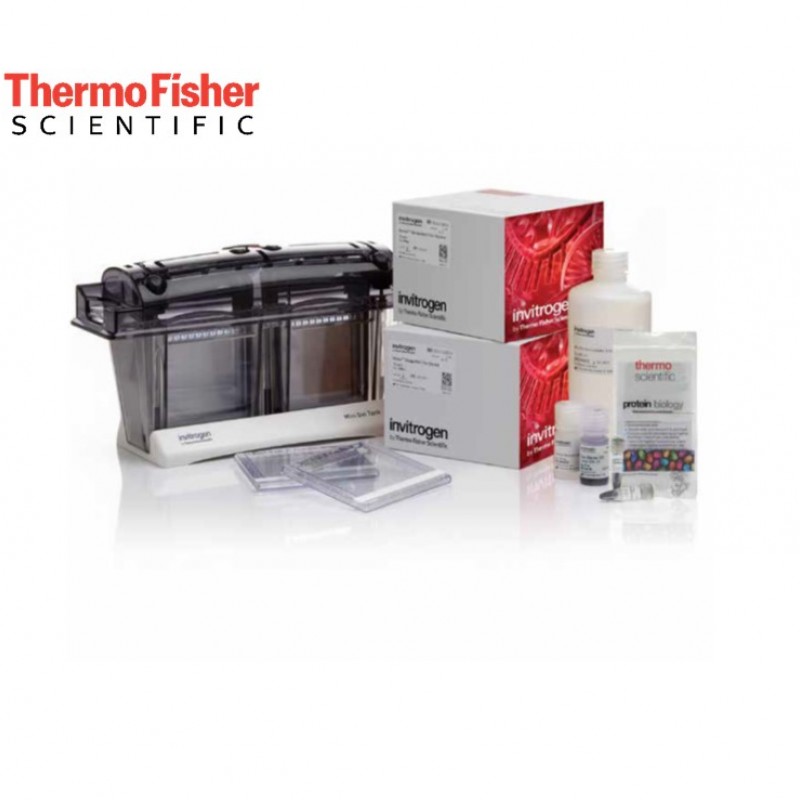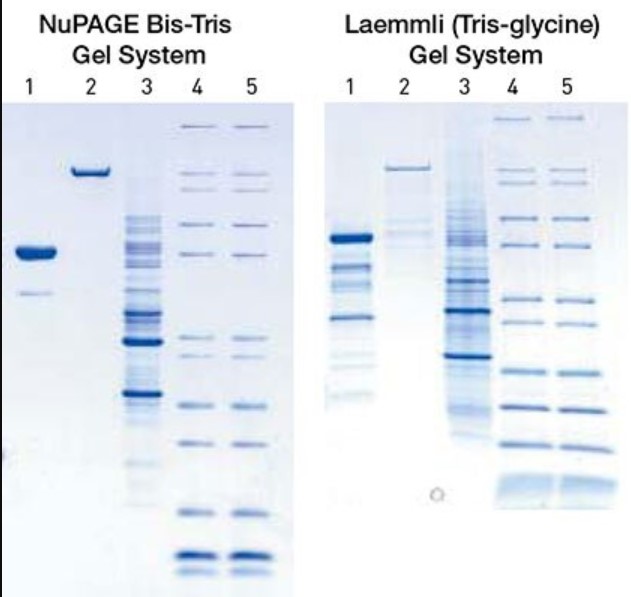
Bis-Tris chemistry in NuPAGE Bis-Tris and Bolt Bis-Tris Plus Gels also promotes stability of the polyacrylamide gel matrix, enabling room temperature storage, which helps save on the need for refrigerator space.
Neutral-pH buffers in NuPAGE Bis-Tris and Bolt Bis-Tris Plus Gels deliver sharp straight bands. During separation, the gels operate close to pH 7. In the Laemmli system (Tris-glycine), the gel is run at basic pH (pH ~9.5). At high pH the residual unpolymerized acrylamide can react with cysteine and lysine residues of the proteins being separated. This may affect downstream analysis such as western blot transfer. At the neutral pH of NuPAGE Bis-Tris and Bolt Bis-Tris Gels, these reactions take place several orders of magnitude more slowly than at the basic pH of Tris-glycine gels, resulting in sharper bands and better resolution.

Sample preparation is a crucial step in successful protein analysis. The pH of the traditional Laemmli-style sample buffer changes from 6.8 to 5.2 when heated at 100°C. This lower pH is known to induce aspartyl-prolyl (Asp-Pro) peptide bond cleavage, which leads to protein degradation. By maintaining a >7.0 pH environment, the Invitrogen NuPAGE LDS Sample Buffer and Bolt LDS Sample Buffer preserve protein integrity by minimizing this Asp-Pro cleavage.
As seen below, the sample integrity is maintained throughout electrophoresis with the Invitrogen NuPAGE system; protein degradation is seen in samples prepared with Laemmli (Tris-glycine) sample buffer. The Invitrogen NuPAGE Antioxidant running buffer additive greatly minimizes protein oxidation during electrophoresis and keeps reduced protein bands sharp and clear.

The unique wedge-shaped well in every Bolt gel provides higher loading capacity, so you can load up to twice as much protein sample in every well.
Detect proteins even in dilute samples or measure expression of low-abundance proteins. With more room to load your sample, you no longer have to worry about sample spillover and cross-well contamination on your western blots. Gel loading is also easier with no need to use special gel-loading pipette tips.

| Well Size | Recommended Loading Volume | Max. Load Volume | Max. Protein Load |
| 10-wel | 40 µL | 60 µL | 0.5 µg/band |
| 12-wel | 30 µL | 45 µL | 0.4 µg/band |
| 15-wel | 20 µL | 35 µL | 0.25 µg/band |
| 17-wel | 15 µL | 30 µL | 0.2 µg/band |
|
|
NuPAGE Bis-Tris
|
Bolt Bis-Tris Plus
|
|
Select when
|
Need flexibility in well and gel format
|
Working with dilute samples or need to load larger sample volumes, or when faster run times are needed
|
|
Available gel sizes
|
Mini: 8 cm x 8 cm (1.0 or 1.5 mm thick)
Midi: 8 cm x 13 cm (1.0 mm thick) |
Mini: 8 cm x 8 cm (1.0 mm thick)
|
|
Storage conditions
|
4–25°C
|
|
|
Shelf life
|
12 months
|
16 months
|
|
High lot-to-lot consistency
|
Coefficient of variation (CV) of only 2% for Rf values (migration)
|
Coefficient of variation (CV) of only 2% for Rf values (migration)
|
|
Recommended sample buffer
|
NuPAGE LDS Sample Buffer
|
Bolt LDS sample buffer
|
|
Recommended running buffers
|
NuPAGE MES SDS or NuPAGE MOPS SDS Running Buffer
|
Bolt MES SDS or Bolt MOPS SDS running buffer
|
|
Run time
|
35 min (MES buffer)
50 min (MOPS Buffer) |
20 min (MES buffer)
35 min (MOPS buffer) |
|
Recommended transfer buffer
|
NuPAGE Transfer Buffer
|
Bolt Transfer Buffer
|
|
Gel chemistry
|
Bis-Tris
|
|
|
Available polyacrylamide concentrations
|
8%, 10%, 12%, 4–12%
|
|
|
Separation range
|
15 kDA to 260 kDa (MOPS buffer)
3.5 kDA to 160 kDa (MES buffer) |
|
|
For use with (equipment) mini gels
|
||
|
Mode of separation
|
Molecular weight
|
|
|
Application
|
SDS-PAGE
|
|
|
Available Wells configurations
|
Mini: 1, 9, 10, 12, 15, 17, 2D-well, IPG well
Midi: 12+2, 20, 26 wells |
WedgeWell format: 10, 12, 15 17 well (load up to 2X sample volume per well)
|
|
For use with (equipment) midi gels
|
SureLock Tandem Midi Gel Tank, Invitrogen XCell4 SureLock Midi-Cell or Bio-Rad Criterion (with adapters only)
|
Not available in midi size
|